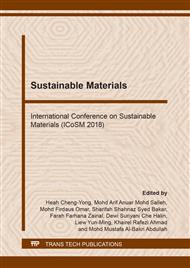p.270
p.277
p.284
p.294
p.301
p.308
p.315
p.323
p.330
Compressive Stress of Syntactic Foam: Effect of rNBR Particles Reinforced Epoxy Macrospheres (rNBR-EM)
Abstract:
This research focuses on the effect of rejected nitrile butadiene rubber (rNBR) gloves particles reinforced epoxy macrospheres (EM) on the physical properties and compressive stress of syntactic foam. Adding rNBR particles on the surface of macrospheres can increase the energy absorption as a result of improving the compressive properties of syntactic foam. Three types of macrospheres have been produced for the fabrication of syntactic foam, namely EM without rNBR, 1-layer rNBR-EM and 2-layer rNBR-EM. The results showed that increased rNBR particles layer on macrospheres has increased the wall thickness, and reduced the radius ratio of macrospheres as well as increased the density of syntactic foams. The compressive strength and modulus of syntactic foam with 2-rNBR-EM increased compared to the syntactic foams of 1-rNBR-EM and EM without rNBR. In addition, the toughness of the 2-rNBR-EM increased compared to the syntactic foams of 1-rNBR-EM and EM without rNBR.
Info:
Periodical:
Pages:
301-307
Citation:
Online since:
August 2018
Authors:
Keywords:
Price:
Сopyright:
© 2018 Trans Tech Publications Ltd. All Rights Reserved
Share:
Citation:


